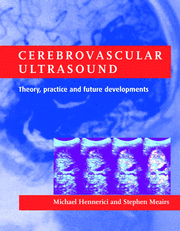Book contents
- Frontmatter
- Dedication
- Contents
- List of contributors
- Preface
- PART I ULTRASOUND PHYSICS, TECHNOLOGY AND HEMODYNAMICS
- PART II CLINICAL CEREBROVASCULAR ULTRASOUND
- (i) Atherosclerosis: pathogenesis, early assessment and follow-up with ultrasound
- (ii) Extracranial cerebrovascular applications
- 14 Carotid and vertebral arteries
- 15 Quantitation and grading of carotid artery stenosis
- 16 Carotid artery pseudo-occlusion
- 17 Standardization of carotid stenosis investigation
- (iii) Intracranial cerebrovascular applications
- PART III NEW AND FUTURE DEVELOPMENTS
- Index
17 - Standardization of carotid stenosis investigation
from (ii) - Extracranial cerebrovascular applications
Published online by Cambridge University Press: 05 July 2014
- Frontmatter
- Dedication
- Contents
- List of contributors
- Preface
- PART I ULTRASOUND PHYSICS, TECHNOLOGY AND HEMODYNAMICS
- PART II CLINICAL CEREBROVASCULAR ULTRASOUND
- (i) Atherosclerosis: pathogenesis, early assessment and follow-up with ultrasound
- (ii) Extracranial cerebrovascular applications
- 14 Carotid and vertebral arteries
- 15 Quantitation and grading of carotid artery stenosis
- 16 Carotid artery pseudo-occlusion
- 17 Standardization of carotid stenosis investigation
- (iii) Intracranial cerebrovascular applications
- PART III NEW AND FUTURE DEVELOPMENTS
- Index
Summary
Introduction
Randomized multicentre clinical trials have identified several features of internal carotid artery disease that are associated with an increased risk of ipsilateral stroke. In both the European Carotid Surgery Trial (ECST) and in the North American Symptomatic Carotid Endarterectomy Trial (NASCET), a benefit for carotid endarterectomy was demonstrated in patients with transient ischemic strokes, minor ischemic strokes or amaurosis fugax and ≥ 70% carotid artery stenosis as confirmed by conventional arteriography. There is good evidence that the risk of stroke in symptomatic carotid artery stenosis is increased by a factor of two in the presence of a plaque ulceration, a thrombus or a stenosis greater than 90%. Moreover, progressive narrowing of the arterial lumen due to plaque enlargement is also associated with an increased stroke risk. Although all of these factors contributing to increased stroke risk can be evaluated by non-invasive techniques such as ultrasonography, magnetic resonance imaging (MRI) and spiral computed tomographic angiography (CTA), lack of internationally standardized criteria for both descriptive and quantitative, non-invasive assessment of carotid artery disease has limited the application of these methods in large multicentre stroke trials. That standardization can be an effective means of improving the reliability of investigations of the carotid artery has been shown for angiography in identification of carotid stenosis of 70% or more diameter reduction (NASCET, 1991; ECST, 1991; ACAS, 1995). Standard examination protocols and specific guidelines for interpreting results therefore, should also improve the reproducibility of clinical imaging studies with ultrasonography, MRI and CTA.
- Type
- Chapter
- Information
- Cerebrovascular UltrasoundTheory, Practice and Future Developments, pp. 249 - 258Publisher: Cambridge University PressPrint publication year: 2001



